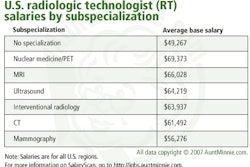
AuntMinnie.com is pleased to present the first installment of a three-part series titled the Deficit Reduction Act Survival Kit. Each part offers concrete suggestions for thriving, not just surviving, in today's DRA environment. This first part will address leadership, and how to establish a management style and structure able to adapt to change.
Much has been written recently about the financial impact of the Deficit Reduction Act (DRA) of 2005. Over the past year, this issue has created some alarming headlines and statements:
- "The DRA ... could chop as much as 20%, and in some cases more, from the revenues of standalone imaging centers in 2007"
- "Radiology reimbursement faces major changes"
- "Deficit reduction cuts may decimate freestanding imaging providers"
- "Congress pickpockets radiology with Deficit Reduction Act"
The hype is based in part on the real impact of the DRA: up to a 45% cut in the physician technical payment for brain MRI and a 31% cut in neck and spine MRI. The diagnostic imaging cuts represent about one-third of the total savings in the DRA. On the other hand, only one-tenth of Medicare spending is on imaging.
In addition to DRA payment cuts for imaging, which took effect January 1, 2007, independent diagnostic imaging facilities (IDIFs) have to meet the terms of the 2007 Medicare Physician Fee Schedule (MPFS). Compliance issues cover a broad territory, from the prohibition of directly soliciting patients to quality issues such as meeting calibration and minimum comprehensive liability insurance standards.
But another threat to income is looming on the horizon. Patients are increasingly going online for help in negotiating fees for high-end outpatient imaging procedures. Those with high deductibles who cannot afford to pay out-of-pocket are getting help from online medical claims adjusters. The bottom line is that imaging centers are accepting lower fees, thereby reducing revenue. It's too early to determine the full extent of the financial impact.
For many radiology groups and imaging centers, the initial response to the DRA and now the 2007 Medicare fee schedule has been based on panic, which in some cases has resulted in crisis planning measures from reducing operational costs, laying off personnel, and adopting hiring freezes, to doing nothing. Unfortunately, none of these tactics addresses the real issues.
The future of outpatient imaging will be a combination of declining reimbursement versus increased demand for imaging services. Add rising competition, staff shortages and ever-changing technology, and you have a perfect storm.
To weather the storm, this three-part article will provide a guide to leading, operating, and growing your imaging center -- despite the current challenges swirling around it.
Leading: Establish a flexible management style and structure
Strategic planning and improvement methods work only if your imaging center has the right operating structure, people, and processes in place. Without effective management and leadership systems, strategic plans will probably gather dust on the shelf.
Some of the management challenges include adhering to federal, state, and local regulations and safety requirements; keeping up with the latest imaging and communications technology; maintaining clinical excellence; managing finances; and recruiting and retaining top talent, from radiologist to receptionist. No other service industry faces so many converging pressures.
Where do you start? The first step in establishing an effective, flexible, and decision-based framework is to gain consensus from all stakeholders on the need to change the way the imaging center thinks and operates, adopting a new approach to managing. Whether you own and operate one freestanding imaging center or have many locations, the need is the same. You have to change to survive. Maintaining the status quo is no longer good enough -- growth is the only option.
You must understand the culture of your organization before any changes can be made. Not recognizing the underlying values and belief systems of your organization ignores basic human drives. Since an imaging center is a professional organization, the role of culture is even more crucial to ensuring the center's viability.
Sometimes, just addressing the subject of culture can become a source of tension and create uncomfortable feelings among the staff, generating questions such as "Why are we talking about this?" and "What does this have to do with our jobs?"
Although culture is a soft concept, research has demonstrated that organizations with a pronounced culture that supports their goals perform significantly better than even their closest competitors.
One imaging center in the South struggled with the dichotomy of trying to determine whether they were a business or medical practice. A survey of the physicians and staff found no consensus on either side. The range of responses to the survey just reinforced how difficult it was going to be to agree on anything. It was impossible to gain consensus on the vision for the imaging center's future.
The management team at this imaging center tried to use backward visioning to help them get a handle on the direction the leadership team should take. Backward visioning creates a picture of the future. This exercise had the group translate an idea of the future into a concrete description of what the imaging center will be doing once success has been realized. The exercise failed, however, because they couldn't agree on the fundamental question of whether they were a business or medical practice.
Culture encompasses the shared beliefs, habits, and traditions of the organization's members. It's manifested by what you do when no one is watching. The culture of the practice can be detected through many tangible and intangible facets, from the clothes the radiologists wear to work, the style of leadership, and the way the partners handle conflict or change, to the attitude of employees, how the technologist greets patients, how a radiologist reports a test result to a referring physician, the way in which rumors are handled, and how the leadership manages damage control.
Management and leadership are two different but interrelated functions. At a high level, leadership should obviously inspire and motivate people to attain the goals of the imaging center. Looking beyond the status quo, true leaders formulate, articulate, and activate a clear vision for the future of the organization. The most successful ones will visibly champion transformational efforts, in part by creating an environment where people feel empowered and equipped to drive change. To achieve accountability and results, leaders must be able to define the linkage between organizational goals and individual or team performance.
Leaders should communicate with staff in a clear and consistent manner so that everyone is aware of the strategic objectives and their own role in the success of the imaging center.
To support the goals established by leadership, management systems within the imaging center will need to provide a coherent structure for all activities that set, drive, and monitor the strategic focus of the business. Key questions include: Does the center have a year-round calendar with meetings and milestones at regular intervals? Is the staff involved in the decision-making process? Do all meetings include a well-defined agenda with action plans?
By Evan Leepson
AuntMinnie.com contributing writer
July 23, 2007
A business and strategy consultant to the diagnostic imaging community, Evan Leepson is a senior consultant for GE Healthcare's Performance Solutions. His speaking engagements have included presentations to the California Radiological Society Annual Meeting, Economics of Diagnostic Imaging: National Symposium, Radiology Business Management Society Annual Meeting, and the American Healthcare Radiology Administrators Annual Meeting.
Related Reading
DRA takes bite out of GE's Q2 numbers, July 16, 2007
It may get worse before it gets better for diagnostic radiology practices, July 9, 2007
The DRA at six months: How outpatient imaging centers are coping, June 26, 2007
RVUs key to tracking radiologist and physician productivity, June 12, 2007
Senators introduce DRA moratorium, May 10, 2007
Copyright © 2007 AuntMinnie.com



















